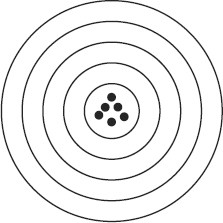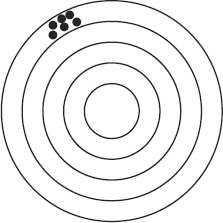Precision vs. Accuracy
The terms “accuracy” and “precision” do not refer to the same idea. Both are important to GIS. A classic example of the difference follows:
Weather forecaster A indicates that it will be between 40 and 50 degrees tomorrow at 4 p.m. The actual reading turns out to be 43. Thus, the forecast was accurate, but not very precise. Forecaster A provided a true statement but without much detail. Forecaster B states that it will be 52.47 degrees at 4 p.m. tomorrow. The temperature turns out to be 43 degrees. Forecaster B was very precise, but not accurate.
The terms accuracy and precision can also be applied to a set of readings or measurements. Again, a classic example: Darts are thrown at targets. The target of person “R” looks like Figure 6-4.
FIGURE 6-4 Good accuracy and good precision

Her dart throwing was both accurate and precise. The darts are where they are intended to be (accurate), and very close together (precise).
Person S’s target looks like Figure 6-5.
FIGURE 6-5 Poor accuracy but good precision

The darts are tightly clustered (they hit a spot almost precisely) but lack accuracy, as they missed the intended spot. (Perhaps some sort of systematic error is present—such as a breeze blowing up and to the left.)
Person T’s target is as shown in Figure 6-6 ...
Get Introducing Geographic Information Systems with ArcGIS: A Workbook Approach to Learning GIS, 3rd Edition now with the O’Reilly learning platform.
O’Reilly members experience books, live events, courses curated by job role, and more from O’Reilly and nearly 200 top publishers.

